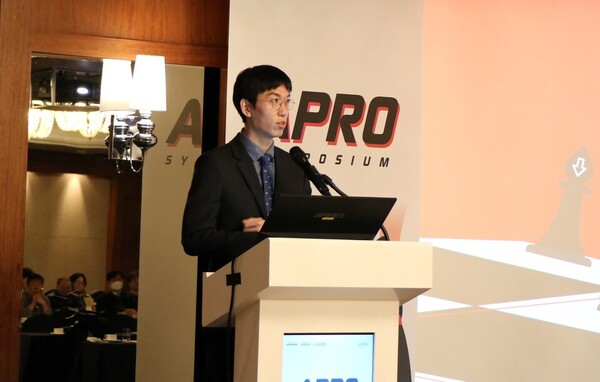Handok hosted the “APRO Symposium" on Tuesday at the Grand Intercontinental Seoul Parnas to celebrate the launch of Aprovasc, a hypertension treatment.

The symposium, organized to commemorate the launch of Aprovasc, the first irbesartan and amlodipine combination drug in Korea, introduced the results of I-DUO 301 and 302 clinical trials, which served as the basis for Korea’s approval of Aprovasc. It also shared the latest domestic and international hypertension treatment guidelines.
Dr. Park Hyun-tae, who once chaired the Gangnam-gu Internal Medicine Association, presided over the symposium. Professor Chun Kyeong-hyeon of the National Health Insurance Service (NHIS) Ilsan Hospital and Professor Won Ho-yeon of Chung-Ang University Hospital delivered lectures.
Aprovasc combines irbesartan, an ARB (angiotensin receptor blocker), and amlodipine, a CCB (calcium channel blocker). Aprovasc is indicated for treating patients with essential hypertension whose blood pressure is not adequately controlled with irbesartan alone.
The active ingredient in Aprovasc, irbesartan, is best known by its single-agent trade name, Aprovel. It is known for its blood pressure-lowering effects in hypertensive patients and its nephroprotective effects in diabetic patients with hypertension.
In the first lecture, Professor Chun introduced the importance of accurate out-of-hospital blood pressure measurement for patients based on the 2023 ESH (European Society of Hypertension) guidelines. He emphasized that most patients are started on two-drug combination therapy for hypertension and that a fixed combination strategy is associated with lower mortality, fewer cardiovascular events, and better treatment adherence compared to single-drug combination therapy.
"In clinical results, Aprovasc demonstrated additional systolic and diastolic blood pressure reductions in patients with uncontrolled hypertension with irbesartan monotherapy," Chun said. "Subgroup analyses showed that these benefits were similar to those seen in the overall population, with no serious adverse drug reactions (SADRs) occurring during the study in patients 65 and older and hypertensive patients accompanied by type 2 diabetes."
In the second lecture, Professor Won said Aprovel has a high binding affinity for the AT1 receptor through the “pentagon attachment,” a structural feature of irbesartan. It can control 24-hour blood pressure and has a long half-life of 11-15 hours.
He explained that in a multicenter study comparing the effectiveness of ARBs, irbesartan showed no significant difference in daytime and nocturnal systolic reduction compared to olmesartan. In a European cohort study of newly diagnosed hypertensive patients, irbesartan had the highest 1-year adherence rate compared to other ARBs and other classes of drugs.
"In older adults, renal and hepatic impairment patients (mild to moderate), dose adjustment is generally not required, making it a good option for point-of-care clinicians," Professor Won added.
Related articles
- Sanofi launches combination treatment for hypertension Aprovasc in Korea
- ‘Adherence is important in treating hypertension, which is why we prescribe combination drugs’
- Handok, SK chemicals ride on original ingredients amid combo drug competition
- Handok secures exclusive rights to distribute Nxera Pharma's stroke prevention Pivlaz
- Handok and Swedish Orphan Biovitrum launch joint venture in Korea

